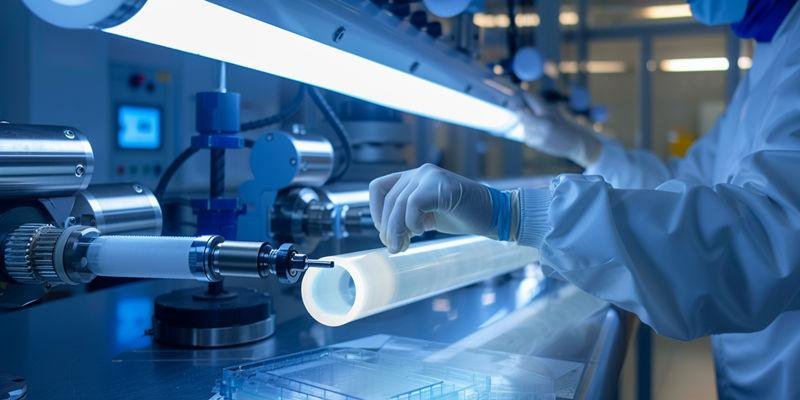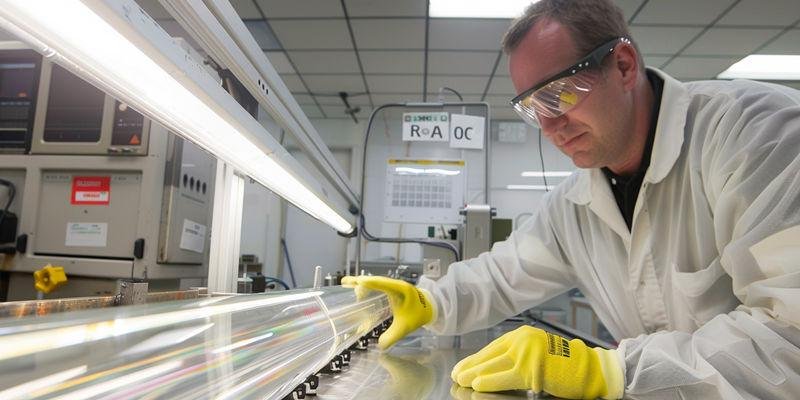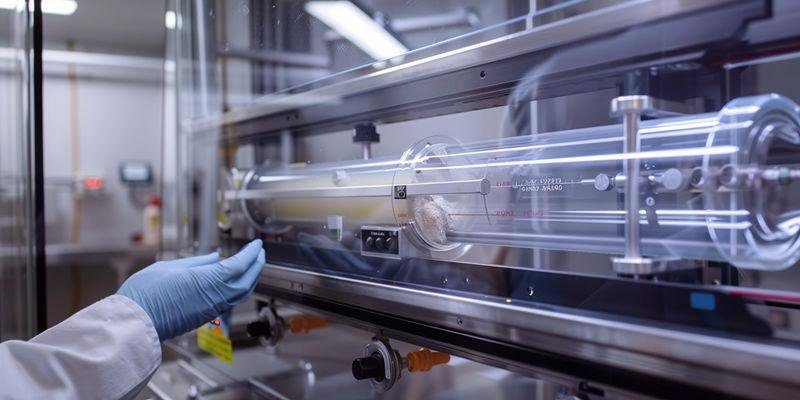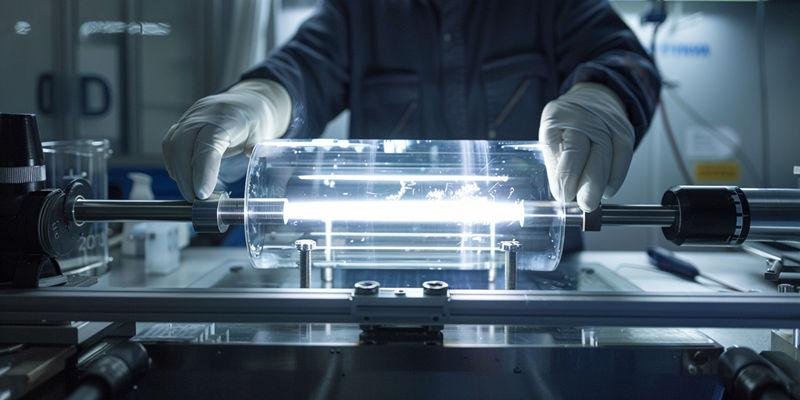신뢰할 수 있는 성능과 비용 효율성을 원하는 엔지니어와 구매자에게 적합한 석영 유리 제조 방법을 선택하는 것은 매우 중요한 결정입니다.
석영 유리 제조는 용융, 성형, 어닐링 및 품질 관리를 통해 고순도 실리카를 유리로 변환합니다. 전기 용융 또는 화염 용융과 같은 공정의 선택은 순도, 비용 및 고급 애플리케이션에 대한 적합성에 직접적인 영향을 미칩니다.
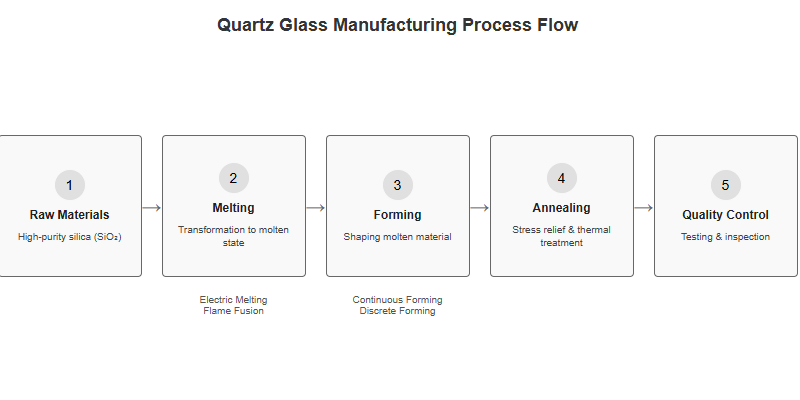
제조 공정의 각 단계를 이해하면 의사 결정자가 기술 요구사항을 상업적 목표에 맞추는 데 도움이 됩니다. 다음 가이드는 모든 단계를 세분화하고 방법 선택을 위한 실용적인 프레임워크를 제공합니다.
석영 유리 제조란 무엇이며 하이테크 애플리케이션에 중요한 이유는 무엇인가요?
석영 유리 제조는 제어된 열 및 기계적 기술을 사용하여 고순도 실리카를 비정질 유리로 변환하는 공정입니다. 반도체, 광학, 광전지 및 실험실 장비의 고성능 부품을 구현하는 데 중요한 역할을 합니다.
석영 유리는 뛰어난 열 안정성, 내화학성 및 광학 선명도를 제공하여 정밀성과 신뢰성이 요구되는 산업에 필수적입니다.
하이테크 애플리케이션을 위한 석영 유리의 주요 특성
| 속성 | 일반적인 값/범위 | 애플리케이션 컨텍스트 |
|---|---|---|
| SiO₂ 순도(%) | ≥99.995 | 반도체, 광학 |
| 작동 온도(°C) | 1,050-1,200(연속) | 고온 처리 |
| 자외선 투과(%) | >90(200nm, 1mm 두께 기준) | 리소그래피, UV 광학 |
| 열팽창(1/K) | ~0.5 × 10-⁶ | 치수 안정성 |
석영 유리 제조의 주요 원자재와 준비 단계는 무엇인가요?
원재료의 품질과 준비는 석영 유리의 성능과 수율의 기초가 됩니다.
고순도 실리카는 주요 재료이지만, 그 공급원, 형태, 전처리는 최종 제품의 투명도와 강도에 직접적인 영향을 미칩니다.
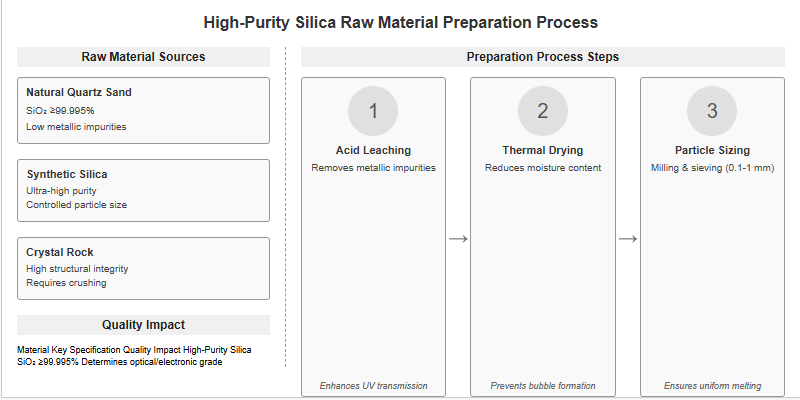
석영 유리 제조를 위한 필수 원자재
핵심 원료는 일반적으로 천연 석영 모래, 합성 실리카 또는 결정암으로 공급되는 고순도 실리카(SiO₂)입니다. 광학 및 전자 등급 유리를 얻으려면 불순물 수준, 특히 금속성 오염 물질을 최소화해야 합니다.
원료 및 준비 개요
| 재료/단계 | 목적/사양 | 품질에 미치는 영향 |
|---|---|---|
| 고순도 실리카 | SiO₂ ≥99.995% | 광학/전자 등급 결정 |
| 산성 침출 | 금속성 불순물 제거 | 자외선 투과율 향상 |
| 열 건조 | 수분 함량 감소 | 거품 형성 방지 |
| 파티클 크기 조정 | 0.1-1mm 일반 | 균일한 용융 보장 |
석영 유리 생산을 위한 원자재는 어떻게 준비되나요?
석영 유리 생산 준비에는 세척, 산 침출 및 열처리가 포함됩니다.1 를 사용하여 표면 오염 물질과 수분을 제거합니다. 밀링 및 체질을 통해 입자 크기를 제어하여 균일한 용융을 보장하고 최종 제품의 결함 위험을 줄입니다.
석영 유리 제조의 용융 방법은 순도와 비용에 어떤 영향을 미칩니까?
용융 공정은 석영 유리 제조의 핵심으로, 재료 순도와 생산 경제성을 모두 좌우합니다.
전기 용융과 화염 융합이라는 서로 다른 용융 방식은 달성 가능한 순도, 처리량, 운영 비용 측면에서 뚜렷한 절충점을 제공합니다.
전기 용융은 석영 유리의 순도와 비용에 어떤 영향을 미치나요?
전기 용해는 고온 저항 용광로를 사용하여 실리카를 액화합니다. 이 방법은 대규모 생산에 효율적이고 비용 효율적이지만 전극이나 용광로 라이닝에서 미량의 금속 불순물이 유입되어 광학 선명도가 약간 떨어질 수 있습니다.
화염 융합은 순도와 생산 비용에 어떤 영향을 미치나요?
화염 융합(산소-수소 또는 플라즈마 토치2)는 오염 물질이 없는 불꽃에서 실리카를 녹여 순도를 높입니다. 이 방법은 반도체 및 광학 애플리케이션에 적합한 초순도 유리를 생산하지만 에너지 소비와 운영 비용이 높습니다.
전기 용융과 화염 융합의 비교 장점은 무엇인가요?
전기 용융은 비용 효율성이 가장 중요한 대량 산업용 석영 유리의 경우 선호됩니다. 화염 용융은 프리미엄 가격에도 불구하고 포토마스크 블랭크나 UV 광학 등 최고 순도를 요구하는 애플리케이션에 선택됩니다.
녹이는 방법 비교
| 방법 | 순도(SiO₂, %) | 일반적인 비용 지수 | 주요 애플리케이션 |
|---|---|---|---|
| 전기 용융 | 99.95-99.995 | 1.0(기준) | 튜브, 막대, 일반 광학 |
| 불꽃 융합 | ≥99.999 | 1.5-2.0 | 반도체, 하이엔드 광학 |
석영 유리 제조에서 성형 및 성형 공정은 어떻게 실행됩니까?
성형 및 성형은 석영 유리 제품의 기하학적 구조, 치수 정확도 및 표면 품질을 결정합니다.
연속 및 개별 성형 방법을 모두 사용한 후 엄격한 공차를 충족하는 정밀 성형이 이루어집니다.
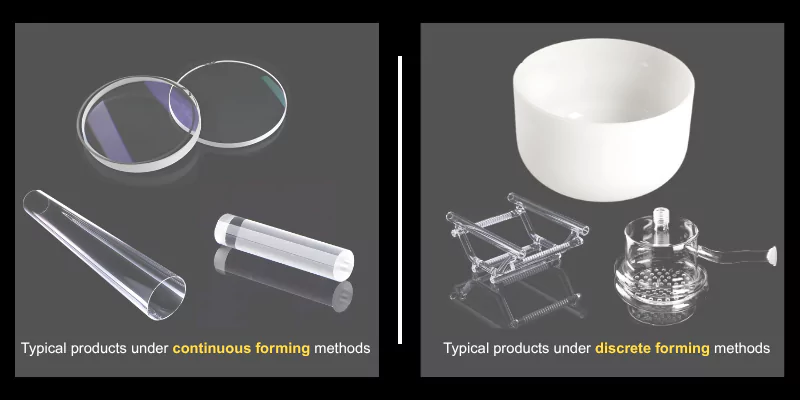
석영 유리 생산에서 연속 성형은 어떻게 적용됩니까?
연속 성형은 용융 석영을 금형을 통해 압출하여 다음을 생산합니다. 튜브, 로드또는 플레이트 의 일관된 단면을 제공합니다. 이 방법은 대량으로 표준화된 제품에 이상적입니다.
제조에서 이산형 성형은 어떻게 구현되나요?
개별 성형은 용융 석영을 주조하거나 압착하여 맞춤형 모양이나 대형 부품을 금형에 넣는 작업입니다. 특수 품목이나 소량 생산에 적합합니다.
석영 유리의 치수 정밀도를 보장하는 성형 기술은 무엇입니까?
정밀 성형에는 연삭, 래핑, CNC 가공이 포함됩니다. 이러한 기술은 광학 및 반도체 애플리케이션에 필요한 엄격한 공차와 표면 마감을 달성합니다.
성형 및 쉐이핑 방법 개요
| 방법/기술 | 일반 허용 오차(mm) | 제품 유형 | 참고 |
|---|---|---|---|
| 연속 성형 | ±0.2-0.5 | 튜브, 막대, 플레이트 | 높은 처리량 |
| 이산 포밍 | ±0.5-1.0 | 사용자 지정 모양, 도가니 | 유연하고 낮은 볼륨 |
| CNC 가공 | ±0.01-0.05 | 렌즈, 웨이퍼, 광학 | 고정밀, 포스트 포밍 |
석영 유리 제조에서 어닐링과 스트레스 해소가 필수적인 이유는 무엇일까요?
어닐링과 응력 완화는 석영 유리 제품의 균열, 뒤틀림 및 내부 결함을 방지하는 데 매우 중요합니다.
제어된 냉각은 용융 및 성형 과정에서 축적된 열 응력을 완화하여 장기적인 내구성과 치수 안정성을 보장합니다.
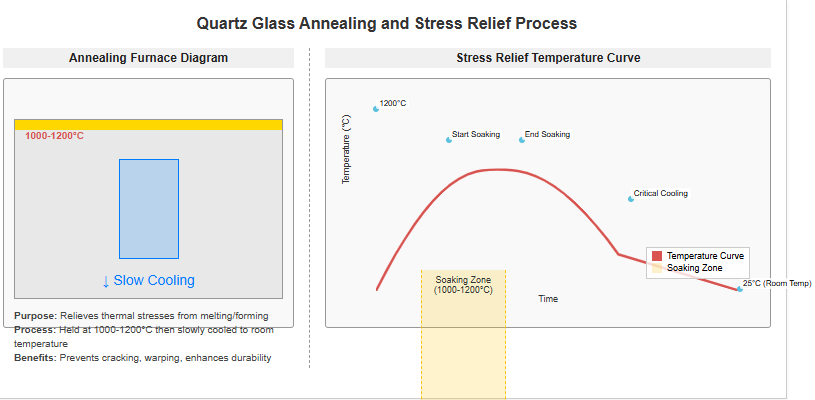
어닐링 과정에서 제품은 특정 온도(일반적으로 1,000~1,200°C)에서 유지된 후 실온으로 천천히 냉각됩니다. 이 과정을 통해 잔류 응력이 제거되고 기계적 강도가 향상됩니다.
석영 유리 제조에서 품질 관리 및 테스트는 어떻게 수행되나요?
품질 관리를 통해 쿼츠 유리는 순도, 형상 및 성능에 대한 엄격한 사양을 충족합니다.
테스트에는 육안 검사, 치수 측정, 분광광도계, 응력 분석이 포함됩니다.
주요 표준으로는 품질 관리를 위한 ISO 9001, 화학 성분을 위한 ASTM E438, 광학 부품을 위한 ISO 10110이 있습니다.
품질 관리 및 테스트 개요
| 테스트/표준 | 목적/매개변수 | 일반적인 요구 사항 |
|---|---|---|
| 육안 검사 | 표면 결함, 기포 | 눈에 보이는 내포물 없음 |
| 분광광도계 | 자외선/가시광선 투과 | >90%, 200nm(두께 1mm) 기준 |
| 치수 확인 | 허용 오차, 평탄도 | 도면/사양에 따라 |
| 스트레스 분석 | 잔여 스트레스 | <5 MPa |
엔지니어와 구매자는 올바른 석영 유리 제조 방법을 어떻게 선택해야 할까요?
최적의 제조 방법을 선택하려면 기술 요구 사항, 비용, 공급업체 역량 간의 균형을 맞춰야 합니다.
구조화된 의사 결정 프레임워크는 엔지니어와 구매자가 위험을 최소화하고 가치를 극대화하는 데 도움이 됩니다.
엔지니어가 방법 선택을 위해 어떤 결정 기준을 사용해야 할까요?
엔지니어는 최종 사용 요구사항(순도, 형상, 광학적 선명도), 생산량, 공차 요구사항을 평가해야 합니다. 예를 들어 반도체 애플리케이션은 초고순도를 위해 화염 용융을 요구할 수 있지만, 일반 실험용품은 전기 용융을 사용할 수 있습니다.
구매자는 어떻게 조달에서 비용과 성능의 균형을 맞출 수 있을까요?
구매자는 초기 가격, 수익률, 장기적인 안정성을 포함한 총소유비용을 비교해야 합니다. 프리미엄 방식의 경우 초기 비용이 더 높을 수 있지만 장애율이 낮고 성능이 우수하기 때문에 정당화될 수 있습니다.
프로젝트 리스크를 최소화하는 공급업체 평가 단계는 무엇인가요?
공급업체 평가에는 인증 검사(ISO, ASTM), 생산 시설 감사, 샘플 테스트, 과거 프로젝트 성과 검토 등이 포함되어야 합니다. 명확한 품질 계약과 커뮤니케이션 채널을 구축하면 위험을 더욱 줄일 수 있습니다.
석영 유리 제조 방법 선택 체크리스트
| 결정 요인 | 주요 질문 | 액션 포인트 |
|---|---|---|
| 순도 요구 사항 | 허용되는 최소 순도는 얼마인가요? | 애플리케이션과 일치하는 방법 |
| 볼륨 및 지오메트리 | 제품이 표준 제품인가요 아니면 사용자 지정 제품인가요? | 연속형 또는 불연속형 선택 |
| 비용 제약 | 총 수명 주기 비용은 얼마인가요? | 초기 비용과 장기 비용의 균형 |
| 공급업체 역량 | 인증 및 실적이 입증되었나요? | 감사 및 샘플 테스트 수행 |
결론
석영 유리 제조의 성공 여부는 공정 선택을 기술 및 상업적 목표에 맞추는 데 달려 있습니다.
석영 유리 제조에서 올바른 선택을 하는 것은 전략적인 과제입니다. 프로젝트의 기술적, 상업적 성공을 보장하기 위해 TOQUARTZ의 직접 공장 공급, 엔지니어링 지원 및 신속한 납품을 활용하세요. 지금 바로 맞춤형 솔루션을 문의하세요.
자주 묻는 질문(FAQ)
석영 유리 제조에서 전기 용융과 화염 용융의 차이점은 무엇인가요?
전기 용융은 대량 생산에 비용 효율적이지만 미량의 불순물이 발생할 수 있는 반면, 화염 융합은 더 높은 비용으로 더 높은 순도를 달성하여 반도체 및 광학 애플리케이션에 이상적입니다.
구매한 석영 유리가 기술 요구 사항을 충족하는지 확인하려면 어떻게 해야 하나요?
자세한 재료 인증서를 요청하고, 공급업체 품질 표준(ISO, ASTM)을 검토하고, 가능하면 순도, 투과율, 치수 정확도를 위해 샘플을 테스트합니다.
석영 유리 공급업체를 선택할 때 가장 중요한 요소는 무엇인가요?
주요 요소로는 기술 역량, 인증, 생산 실적, 응답성, 맞춤형 솔루션 제공 능력 등이 있습니다.
어닐링은 석영 유리 제품의 품질을 어떻게 개선하나요?
어닐링은 내부 응력을 완화하고 균열을 방지하며 장기적인 치수 안정성과 기계적 강도를 보장합니다.
참조:


